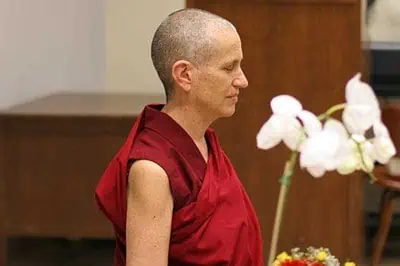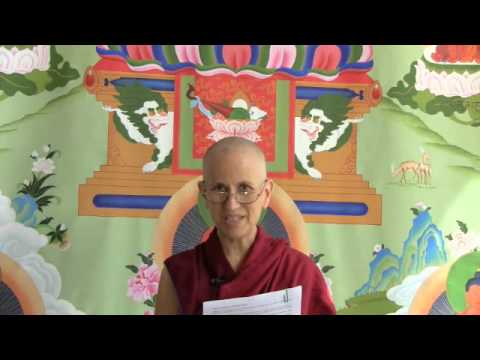Visualizing the merit field
Stages of the Path #53: Refuge Ngöndro Part 2
Part of a series of short talks on the preliminary practice (ngöndro) of taking refuge.
- Accumulating merit by reciting refuge mantras
- A description of the refuge field (visualization)
- How the Buddhas appear in different ways for our benefit
- When visualizing it’s not necessary to have everything perfectly clear
Stages of the Path 53: Refuge visualization (download)
Today I’m going to talk about the preliminary practice of going for refuge, where you accumulate a lot of merit by reciting refuge mantras and also meditating very deeply about the meaning of refuge. To describe the visualization, Dallas has found a very nice photo.
In the center is Śākyamuni Buddha. We are seeing our spiritual mentor in the photo of Śākyamuni Buddha. On the Buddha’s right, or on our left as we look at it, is Maitreya surrounded by the lineage of what’s called the Vast Lineage, because it teaches all the vast practices of the bodhisattva that are motivated by compassion. On the Buddha’s left, or on our right as we look at it, is Mañjuśrī surrounded by all the Buddhas of the Profound Lineage that specialize in teaching emptiness. Then next, and here it’s above the Buddha, but actually when you’re visualizing it three-dimensionally, it’s behind the Buddha—is Vajradhāra surrounded by the lineage teachers of the Blessings of the Practice, who give the tantric initiation. In front of the Buddha—it’s very small here—you have your own teachers, with your root teacher in the center surrounded by all your other teachers.
Here again, it’s done three-dimensionally because it’s actually on a throne, although I don’t think there is any fault in doing it where they’re below, but immediately below the Buddha you have the four great, highest-class tantra deities: Vajrabhairava (Dorje Jigje), Chakrasaṃvara, Kālacakra, and Guhyasamāja. Then you have four rows of deities, one for each of the classes of tantra, then a row of Buddhas that include the Thousand Buddhas of the Fortunate Aeon, the seven (or sometimes eight) Medicine Buddhas, the 35 Buddhas, all the other Buddhas. After the Buddhas, you have a row of bodhisattvas, after them the solitary realizer arhats in a row, then the hearer arhats in a row, then a row of ḍākas and ḍākinīs, and then a row of the transcendental Dharma protectors; in other words, the Dharma protectors that are āryas, that have realized emptiness. Here you have it all. It is set out two-dimensionally so you can adjust it when you visualize it three-dimensionally.
Another way of doing it, is that there is one central throne and there are five small thrones on it. The center throne is your teacher in the aspect of the Buddha. The throne in front of him is your teacher in the ordinary aspect surrounded by your other teachers. On the Buddha’s right again is Maitreya on the throne and the Vast Lineage; on the Buddha’s left, Mañjuśrī on a throne with the Profound Lineage; and then on the back throne Vajradhāra with the lineage of teachers that’s called the Blessings of the Practice.
The idea here, in visualizing all of them, is that you start with the Dharmakāya mind—that is, the omniscient mind that each Buddha has, and of course the emptiness and true cessations of those minds. The Buddha’s mind, the omniscient mind appears in all these various aspects for the benefit of sentient beings. Why? Because sentient beings have different dispositions, different tendencies, different preferences, different likes and dislikes; and so in order to communicate with us, the omniscient minds appear in all these different aspects—because we’re very attached to form and color, and we see people, and things like that. They have to appear in these different ways to communicate with us. If you think like this, then you think, in terms of the nature of all these holy beings, they have the same nature. What is that nature? It is the nature of emptiness, the nature of knowing all phenomena, the nature of compassion, the nature of wisdom, so on and so forth. They share the same nature but they are appearing in these aspects in order to communicate with us.
If you see all of them in that way, then your mind doesn’t make divisions so much between, “Well, I take refuge in this one but I don’t take refuge in that one. This one is a good guy but that one is a bad guy.” Instead you see them all as working towards your benefit, but they all work to benefit you in slightly different ways. You’ll notice when we did the tsok offering, for example, on the lunar 10th and 25th, when we offer to each group—there’s a particular request that we make, and that request corresponds with how that particular group benefits us. In addition, we can think of how the Buddhas appear in these different aspects, how one aspect can benefit us in a particular way more than other aspects can; and then the other aspect can benefit in a way that the previous one can’t, and so on and so forth.
It is kind of like the omniscient minds wearing different costumes or clothes to do different activities or to communicate with us in different ways. Thinking like this helps us, first of all to overcome the grasping at inherent existence as if all these figures are individual people. It also helps us to really see that they’re all one nature and working for us in a mutually complementary way.
When you do the visualization, do it as best as you can but don’t expect yourself to get all the figures immediately clear. It’s like when you walk in a room full of a lot of people, you don’t see everybody clearly. You might pick out the person who’s leading the activity and focus more on them, and then you just have an awareness that the other people are there, sometimes shifting your focus to one person or one group or another, according to what’s on the program of events of the activity that you’re attending.
Another way, if you feel that this visualization is just too complicated, is just to visualize the Buddha as one figure and see the Buddha as the embodiment of the Buddha, Dharma, and Sangha.
This photo is in the book, The Mystical Arts of Tibet. I’m sure there are other pictures as well but you might be able to find some online, for people who aren’t here.
Venerable Thubten Chodron
Venerable Chodron emphasizes the practical application of Buddha’s teachings in our daily lives and is especially skilled at explaining them in ways easily understood and practiced by Westerners. She is well known for her warm, humorous, and lucid teachings. She was ordained as a Buddhist nun in 1977 by Kyabje Ling Rinpoche in Dharamsala, India, and in 1986 she received bhikshuni (full) ordination in Taiwan. Read her full bio.


